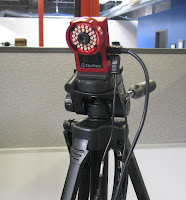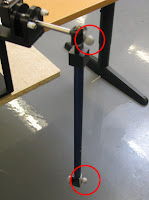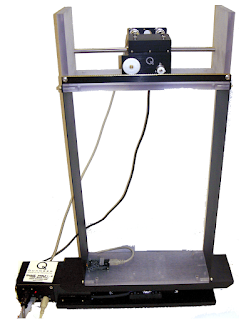 t. For certain applications, for example unmanned aerial vehicles or ground vehicles, this can be quite challenging. That is why we have integrated the NaturalPoint OptiTrack camera system into QuaRC. The OptiTrack camera system consists of three or more synchronized infrared (IR) cameras that capture images containing reflective markers within a workspace. The cameras emit IR light from an array of IR LEDs, and the IR light reflected by the special markers is picked up by the cameras and seen as bright spots on the image. Software then processes the images from the collection of cameras and determines the position of each marker in the 3D workspace. Rigid bodies (rigid shapes made up of 3 or more reflective markers) can be constructed and tracked in 6-DOF (position and orientation).
t. For certain applications, for example unmanned aerial vehicles or ground vehicles, this can be quite challenging. That is why we have integrated the NaturalPoint OptiTrack camera system into QuaRC. The OptiTrack camera system consists of three or more synchronized infrared (IR) cameras that capture images containing reflective markers within a workspace. The cameras emit IR light from an array of IR LEDs, and the IR light reflected by the special markers is picked up by the cameras and seen as bright spots on the image. Software then processes the images from the collection of cameras and determines the position of each marker in the 3D workspace. Rigid bodies (rigid shapes made up of 3 or more reflective markers) can be constructed and tracked in 6-DOF (position and orientation).We have integrated the OptiTrack camera system in QUARC so that the designer can use a simple set of QUARC blocks in Simulink to track individual markers or
 rigid bodies. To test the performance of the system, we wanted to see if it was possible to control a standard inverted pendulum experiment using visual feedback instead of the standard encoder feedback. To control the inverted pendulum you must be able to measure the pendulum base arm angle and the angle of pendulum. We placed refective markers on an inverted pendulum experiment and used a simple QUARC block to interface with the OptiTrack system to measure the marker positions. Knowing the marker positions, we can determine the angle of the pendulum base arm and the angle of the pendulum so that it can be controlled.
rigid bodies. To test the performance of the system, we wanted to see if it was possible to control a standard inverted pendulum experiment using visual feedback instead of the standard encoder feedback. To control the inverted pendulum you must be able to measure the pendulum base arm angle and the angle of pendulum. We placed refective markers on an inverted pendulum experiment and used a simple QUARC block to interface with the OptiTrack system to measure the marker positions. Knowing the marker positions, we can determine the angle of the pendulum base arm and the angle of the pendulum so that it can be controlled.The following video shows the results of this experiment. As you can see, it is possible to stabilize the inverted pendulum using vision-based feedback. The OptiTrack system combined with QUARC is a powerful new control tool, opening up the possibility for many new control experiments. Objects that were previously difficult to track, such as indoor autonomous vehicles, can now be tracked by adding reflective markers.





















